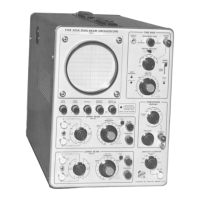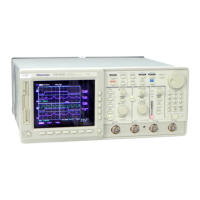SECTION 3
CIRCUIT DESCRIPTION
Introduction
This section contains the theory of operation of the various
circuits in the Type 544. A simplified block diagram analysis
is given first to explain the operation of each circuit in gen
eral terms, then the operation of each circuit is covered
in detail.
BLOCK DIAGRAM ANALYSIS
In the following analysis, it is assumed that the oscilloscope
is equipped with a vertical plug-in preamplifier, and that the
horizontal display switch is set in the NORMAL XI position.
Fig. 3-1 is a simplified block diagram showing the Type 544
operating in this mode. The functions of the various blocks
in Fig. 3-1 are explained in the following paragraphs.
Low-Voltage Power Supply. The low-voltage power sup
ply produces all operating voltages for the oscilloscope with
the exception of parts of the crt circuit. The low-voltage
supply provides regulated —150, +100, +225, and +350
volts. It also provides heater voltages and an unregulated
+ 325-volt output.
Vertical Plug-In Preamplifier. Any Tektronix letter-series
or 1-series vertical plug-in preamplifier can be used with the
Type 544. For a circuit description of the plug-in unit, refer
to the plug-in unit instruction manual.
Vertical Input Amplifier. The vertical input amplifier is a
balanced, hybrid amplifier that amplifies the output of the
plug-in vertical preamplifier and applies the amplified verti
cal signal to the trigger-pickoff circuit and the vertical output
amplifier.
Delay Line. The push-pull output of the vertical input ampli
fier is applied through the balanced delay line to the verti
cal output amplifier. The delay line is a specially braided
186-ohm line which delays the application of the vertical sig
nal to the vertical output amplifier for 170 nsec. This pro
vides time for unblanking the crt and starting the horizontal
sweep before the vertical signal reaches the deflection plates.
The delay allows the leading edge of a single fast-rising
pulse to be displayed. The delay line requires no adjustment
because of the precision construction.
Vertical Output Amplifier. The vertical output amplifier is
a push-pull, three-stage, transistor amplifier that takes the
output of the delay line and amplifies it to a level sufficient
to drive the vertical deflection plates of the crt.
Trigger-Pickoff Circuit. The trigger-pickoff circuit applies
a sample of the input waveform to the trigger circuits of
both time bases. The trigger is picked off at the output of
the vertical input amplifier.
Time Base Generator. The Time Base generator provides
accurate ramp voltages for the horizontal deflection system,
unblanking for the crt, and a + GATE OUT to a front-panel
connector. The Time Base generator may be triggered by
signals derived from either internal or external sources.
Horizontal Amplifier. The input to the horizontal amplifier
is selected from the outputs of the Time Base generator, or
the external horizontal input amplifier. The selected input is
split in phase and amplified to provide push-pull drive to
the horizontal deflection plates of the crt.
External Horizontal Amplifier. The external horizontal in
put amplifier provides the necessary gain to drive the hor
izontal amplifier from external signals. An input attenuator
and a gain control provide horizontal deflection factors from
0.1 to about 10 volts/cm.
Crt Power Supply. The crt power supply provides the high
voltages for operating the crt. The power supply is of the rf
type, using a 50-kc Hartley oscillator. Secondary windings
on the oscillator transformer supply voltages to the high-
voltage rectifiers.
Cathode Ray Tube (Crt). The cathode-ray tube used in the
Type 544 is a flat-faced, internal graticule, 5-inch tube with
6 cm of useable vertical scan area. The tube is designed for
low input capacitance to the vertical deflection plates and
minimum X-axis center-to-edge defocusing.
Calibrator. The calibrator in the Type 544 is a multivibrator
and cathode follower that provides a square-wave output
with a maximum amplitude of 100 volts at a nominal 1 kc.
A step attenuator permits switching the output amplitude from
the front panel. In the 0.2-mvolt to 200-mvolt range, the out
put impedance is 50fi.
CIRCUIT ANALYSIS
The following circuit analysis of the Type 544 describes the
operation of the various circuits in detail. While reading
through the description of a particular circuit, refer to the cir
cuit diagram being discussed (see Section 6).
Low-Voltage Power Supply
The low-voltage power supply in the Type 544 (see Power
Supply schematic) actually consists of four interrelated sup
plies that operate together as a system. This system delivers
filtered and regulated voltages of —150, +100, +225, and
+350 volts as well as unregulated dc voltage of +325 volts.
A common power transformer, T601, supplies the input power
to each of the supplies, as well as heater power to time-delay
relay K600 and the tubes in the oscilloscope. Unless other
wise specified, the Type 544 is shipped with T601 wired for
115-volt ac input. A connection diagram on the side of the
transformer shows alternate connections for other input volt
ages.
The 115-volt ac input is applied to T601 through POWER
ON switch SW601. Overload protection is provided by fuse
F601. Thermal cutout TK601 in the primary circuit of T601 is
a protective device that opens the transformer primary circuit
if the temperature inside the oscilloscope rises above a safe
value. TK601 resets automatically when temperatures return
to normal, and to shorten the cooling time, the fan continues
to run while TK601 is open (except when T601 is connected
®!
3-1

